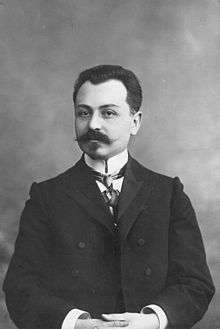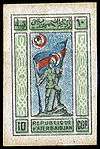Fatali Khan Khoyski
| Fatali Khan Khoyski Fətəli-xan Xoyski | |
|---|---|
 | |
| Minister of Foreign Affairs of Azerbaijan Democratic Republic (ADR) | |
|
In office 26 December 1918 – 14 March 1919 | |
| President | Alimardan Topchubashov (Chairman of Azerbaijani Parliament) |
| Preceded by | Alimardan Topchubashev |
| Succeeded by | Mammad Yusif Jafarov |
|
In office 24 December 1919 – 1 April 1920 | |
| President | Mammad Yusif Jafarov (Chairman of Azerbaijani Parliament) (acting) |
| Preceded by | Mammad Yusif Jafarov |
| Succeeded by | office eliminated |
| Minister of Internal Affairs of ADR | |
|
In office 28 May 1918 – 17 June 1918 | |
| Preceded by | office created |
| Succeeded by | Behbud Khan Javanshir |
| Minister of Defense of ADR | |
|
In office 18 November 1918 – 25 December 1918 | |
| Preceded by | office re-established |
| Succeeded by | Samedbey Mehmandarov |
| Chairman of the Council of Ministers of the Azerbaijan Democratic Republic | |
|
In office 28 May 1918 – 14 April 1919 | |
| Preceded by | Office established |
| Succeeded by | Nasib Yusifbeyli |
| Personal details | |
| Born |
7 December [O.S. 25 November] 1875 Shaki, Elisabethpol Governorate, Russian Empire |
| Died |
19 June 1920 (aged 44) Tbilisi, Democratic Republic of Georgia |
| Religion | Islam |
Fatali Khan Isgender oglu Khoyski (Azerbaijani: Fətəli-xan İsgəndər oğlu Xoyski; 7 December [O.S. 25 November] 1875 – 19 June 1920) was an attorney, a member of the Second State Duma of the Russian Empire, Minister of Internal Affairs, Minister of Defense and, later the first Prime Minister of the independent Azerbaijan Democratic Republic.[1]
Early life
Khoyski was born on 7 December [O.S. 25 November] 1875 in Shaki to the noble family of Isgender Khoyski, a colonel in the Russian Army.[2][3] His great grandfather Jafar Qoli, the Khan of Khoy was defeated by the Iranian Fath-Ali Shah and with his 20,000 army retreated to Echmiadzin. In the 1804-1813 Russo-Persian war, Jafar Qoli Khan sided with Russian Empire and was therefore rewarded by tsar Alexander I by being appointed the Khan of Shaki Khanate and his rank was raised to Lieutenant Colonel.[4]
After receiving his school education at Ganja gymnasium, Fatali Khan studied at the Law Faculty of the Moscow University, from which he graduated in 1901. After the graduation, Khoyski worked as a court lawyer in Ganja, Sukhumi, Batumi, Kutaisi. Once he was appointed Assistant Prosecutor of Yekaterinodar county court, he began to be involved in socio-political activities.
Political career
Russian Empire

Khoyski was elected a deputy to the Second Duma of Russian Empire from Elisabethpol Governorate. While delivering a speech before the Duma on 2 February 1907, he criticized the Russian colonization policies in Azerbaijan and the Caucasus. Although he was formally registered with Constitutional Democratic Party (known as the Kadets), he also joined the Muslim fraction in Duma.[4] On 27 March, soon after the 1917 February revolution in Russia, Khoyski became a member of the Temporary Executive Committee of Muslim National Councils (MNCs). During the first Musavat summit on 26–31 October 1917, Khoyski spoke in favor of autonomy for Azerbaijan. In December 1917, he was elected a member of the newly created Transcaucasian Sejm and subsequently appointed the Minister of Justice of an independent Transcaucasian Democratic Federative Republic.
Azerbaijan Democratic Republic
On 28 May 1918, the republic dissolved and an independent Azerbaijan Democratic Republic was proclaimed. It was the first state ever in the Muslim world to function and be based on principles of republic government. Fatali Khan was put in charge of forming the first cabinet of the republic.

Khoyski served as the Chairman of Cabinet of Ministers and Minister of Internal Affairs. On 17 June 1918 the second government was formed by Khoyski led by Nasib Yusifbeyli. He played a significant role in making alliance with the Turkish government, defeating and removing the Centrocaspian Dictatorship from power in Baku as well as establishing diplomatic ties with other countries as the Foreign Minister. He is also credited for establishing the Azerbaijan State University. During the period of the third government formed by Khoyski, he served as Chairman of the National Council and Minister of Foreign Affairs of Azerbaijan. During his term in office, he succeeded in removing the city names Elisabethpol and restoring the historic name of Ganja and renaming the Karyagino county to Jabrayil province, establishing a multi-party system, printing of Azerbaijani postage stamps and Azerbaijani currency Manat, founding schools and colleges teaching in Azerbaijani. In March 1919, the third government dissolved.
In January 1920, when the Allied Powers de facto recognized Azerbaijan Democratic Republic,Council of Allied Powers,[5] Georgy Chicherin, the Soviet Commissar for Foreign Affairs repeatedly mailed Khoyski asking him to open a new front to confront Anton Denikin and his White movement to which Fatali Khan gave negative responses saying ADR would not meddle into internal affairs of Russia. In his fourth last correspondence, Chicherin notified Khoyski about the upcoming invasion of the 11th Red Army of Azerbaijan. Khoyski moved his family to Tbilisi before the Bolshevik Red Army invaded Baku on 28 April 1920.
Assassination
Fatali Khan Khoyski was assassinated in Tiflis, near the central Erivan Square on 19 June 1920 by Aram Yerganian[6] as part of Operation Nemesis organised by the Armenian Revolutionary Federation (ARF).[7] The ARF accused Khoyski in having played a major role in the September 1918 massacre of Armenians in Baku.[8]
His burial ceremony was arranged by the Persian consulate in Tiflis.[9]
See also
References
- ↑ "Presidential Library. Fatali Khan Khoyski" (PDF). p. 70. Retrieved 2010-07-09.
- ↑ ХРОНОС — всемирная история в интернете. Хойский Фатали Хан Искендер оглы
- ↑ Fuad Akhundov, "Fatali Khoyski - Prime Minister (1875-1920), Azerbaijan International, vol. 6.1, Spring 1998.
- 1 2 "Ministers of Foreign Affairs of Azerbaijan. Fatali Khan Khoyski". Retrieved 2010-07-09.
- ↑ Fuad Akhundov (Spring 1998). "Alimardan Topchubashev - Minister of Foreign Affairs (1862-1934)". Azerbaijan International. p. 31. Retrieved 2010-07-09.
- ↑ Derogy, Jacques (1990). Resistance and Revenge: The Armenian Assassination of the Turkish Leaders Responsible for the 1915 Massacres and Deportations. Transaction Publishers. p. 61. ISBN 9781412833165.
- ↑ Motta, Giuseppe (2013). Less than Nations: Central-Eastern European Minorities after WWI, Volume 2. Cambridge Scholars Publishing. p. 18. ISBN 9781443854290.
- ↑ Newton, Michael (2014). Famous Assassinations in World History: An Encyclopedia. ABC-CLIO. pp. 269–270. ISBN 9781610692861.
- ↑ "Storm over the Caucas: A glance at the Iranian regional relations with the republics of Azerbaijan, Armenia and Georgia in the first period of independence 1917-1921" ( In Persian), Kaveh Bayat, The center for documents and diplomatic history, Tehran 2001, First ed., ISBN 964-361-065-9, p. 410